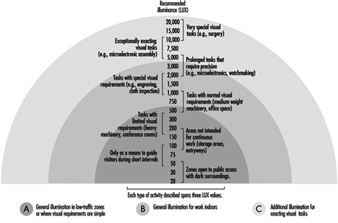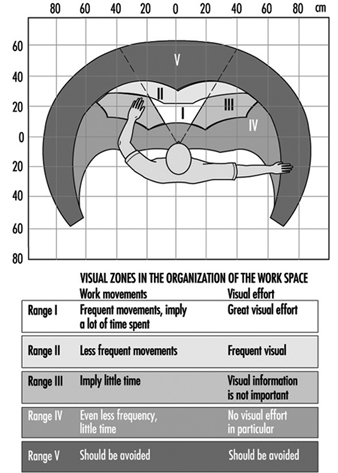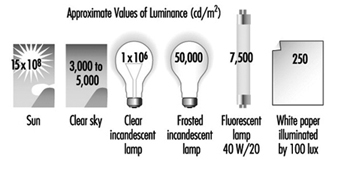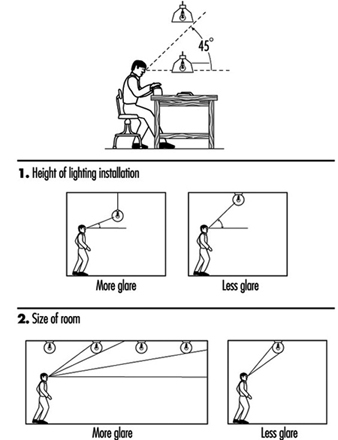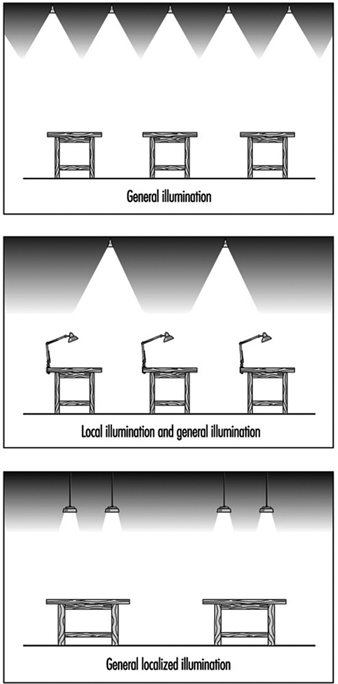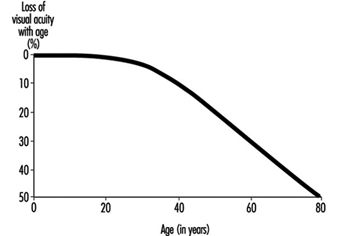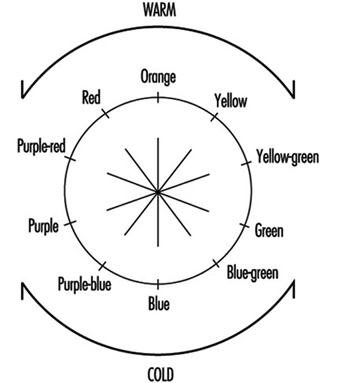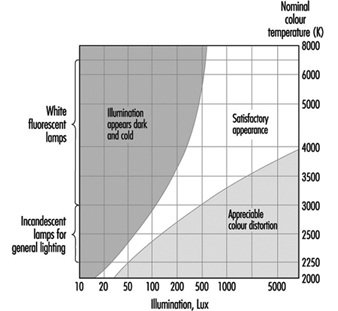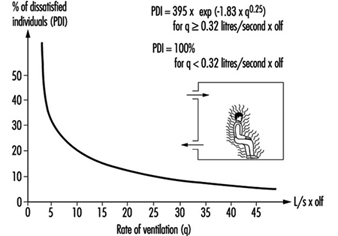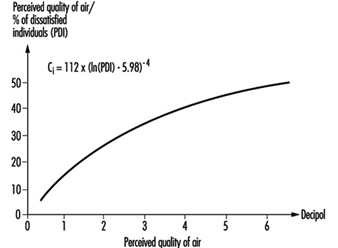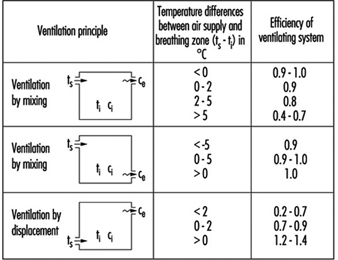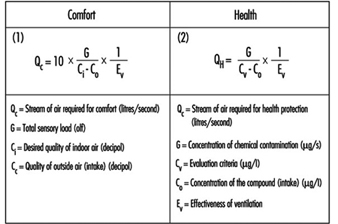Hernández Calleja, Ana
Address: National Centre for Working Conditions, National Institute for Occupational Safety and Hygiene, Calle Dulcet 2-10, 08034 Barcelona
Country: Spain
Phone: 34 3 280 0102
Fax: 34 3 280 3642
Education: Ciencias Biológicas, 1982
Areas of interest: Industrial hygiene; evaluation of biological contaminants; closed building syndrome
Conditions Required for Visual Comfort
Human beings possess an extraordinary capacity to adapt to their environment and to their immediate surroundings. Of all the types of energy that humans can utilize, light is the most important. Light is a key element in our capacity to see, and it is necessary to appreciate the form, the colour and the perspective of the objects that surround us in our daily lives. Most of the information we obtain through our senses we obtain through sight—close to 80%. Very often, and because we are so used to having it available, we take it for granted. We should not fail to keep in mind, however, that aspects of human welfare, like our state of mind or our level of fatigue, are affected by illumination and the colour of the things that surround us. From the point of view of safety at work, visual capacity and visual comfort are extraordinarily important. This is because many accidents are due to, among other reasons, illumination deficiencies or errors made by the worker because he or she finds it hard to identify objects or the risks associated with machinery, conveyances, dangerous containers and so on.
Visual disorders associated with deficiencies in the illumination system are common in the workplace. Due to the ability of sight to adapt to situations with deficient lighting, these aspects are sometimes not considered as seriously as they should be.
The correct design of an illumination system should offer the optimal conditions for visual comfort. For the attainment of this goal an early line of collaboration between architects, lighting designers and those responsible for hygiene at the worksite should be established. This collaboration should precede the beginning of the project, to avoid errors that would be difficult to correct once the project is completed. Among the most important aspects that should be kept in mind are the type of lamp that will be used and the lighting system that will be installed, the distribution of luminance, illumination efficiencies and the spectral composition of light.
The fact that light and colour affect the productivity and the psycho-physiological well-being of the worker should encourage the initiatives of illumination technicians, physiologists and ergonomists, to study and determine the most favourable conditions of light and colour at each work station. The combination of illumination, the contrast of luminances, the colour of light, the reproduction of colour or the selection of colours are the elements that determine colour climate and visual comfort.
Factors that Determine Visual Comfort
The prerequisites that an illumination system must fulfil in order to provide the conditions necessary for visual comfort are the following:
- uniform illumination
- optimal luminance
- no glare
- adequate contrast conditions
- correct colours
- absence of stroboscopic effect or intermittent light.
It is important to consider light in the workplace not only by quantitative criteria, but also by qualitative criteria. The first step is to study the work station, the precision required of the tasks performed, the amount of work, the mobility of the worker and so on. Light should include components both of diffuse and of direct radiation. The result of the combination will produce shadows of greater or lesser intensity that will allow the worker to perceive the form and position of objects at the work station. Annoying reflections, which make it harder to perceive details, should be eliminated, as well as excessive glare or deep shadows.
The periodic maintenance of the lighting installation is very important. The goal is to prevent the ageing of lamps and the accumulation of dust on the luminaries that will result in a constant loss of light. For this reason it is important to select lamps and systems that are easy to maintain. An incandescent light bulb maintains its efficiency until the moments before failure, but this is not the case with fluorescent tubes, which may lower their output down to 75% after a thousand hours of use.
Levels of illumination
Each activity requires a specific level of illumination in the area where the activity takes place. In general, the higher the difficulty for visual perception, the higher the average level of illumination should be as well. Guidelines for minimal levels of illumination associated with different tasks exist in various publications. Concretely, those listed in figure 1 have been gleaned from European norms CENTC 169, and are based more on experience than on scientific knowledge.
Figure 1. Levels of illumination as a function of tasks performed
The level of illumination is measured with a luxometer that converts luminous energy into an electrical signal, which is then amplified and offers an easy reading on a calibrated scale of lux. When selecting a certain level of illumination for a particular work station the following points should be studied:
- the nature of the work
- reflectance of the object and of the immediate surroundings
- differences with natural light and the need for daytime illumination
- the worker’s age.
Units and magnitudes of illumination
Several magnitudes are commonly used in the field of illumination. The basic ones are:
Luminous flux: Luminous energy emitted per unit of time by a light source. Unit: lumen (lm).
Luminous intensity: Luminous flux emitted in a given direction by a light that is not equally distributed. Unit: candela (cd).
Level of illumination: Level of illumination of a surface of one square metre when it receives a luminous flux of one lumen. Unit: lux = lm/m2.
Luminance or photometric brilliance: Is defined for a surface in a particular direction, and is the relation between luminous intensity and the surface seen by an observer situated in the same direction (apparent surface). Unit: cd/m2.
Contrast: Difference in luminance between an object and its surroundings or between different parts of an object.
Reflectance: Proportion of light that is reflected by a surface. It is a non-dimensional quantity. Its value ranges between 0 and 1.
Factors that affect the visibility of objects
The degree of safety with which a task is executed depends, in large part, on the quality of illumination and on visual capacities. The visibility of an object can be altered in many ways. One of the most important is the contrast of luminances due to reflection factors, to shadows, or to colours of the object itself, and to the reflection factors of colour. What the eye really perceives are the differences of luminance between an object and its surroundings, or between different parts of the same object. Table 1 lists the contrasts between colours in descending order.
The luminance of an object, of its surroundings, and of the work area influence the ease with which an object is seen. It is therefore of key importance that the area where the visual task is performed, and its surroundings, be carefully analysed.
Table 1. Colour contrasts
|
Colour contrasts in descending order |
|
|
Colour of the object |
Colour of the background |
|
Black |
Yellow |
|
Green |
White |
|
Red |
White |
|
Blue |
White |
|
White |
Blue |
|
Black |
White |
|
Yellow |
Black |
|
White |
Red |
|
White |
Green |
|
White |
Black |
The size of the object that must be observed, which may be adequate or not depending on the distance and the angle of vision of the observer, is another factor. These last two factors determine the arrangement of the work station, classifying different zones according to their ease of vision. We can establish five zones in the work area (see figure 2).
Figure 2. Distribution of visual zones in the work station
Another factor is the time frame during which vision occurs. The time of exposure will be greater or smaller depending on whether the object and the observer are static, or whether one or both of them are moving. The adaptive capacity of the eye to adjust automatically to the different illuminations of objects can also have considerable influence on visibility.
Light distribution; glare
Key factors in the conditions that affect vision are the distribution of light and the contrast of luminances. In so far as the distribution of light is concerned, it is preferable to have good general illumination instead of localized illumination in order to avoid glare. For this reason, electrical accessories should be distributed as uniformly as possible in order to avoid differences in luminous intensity. Constant shuttling through zones that are not uniformly illuminated causes eye fatigue, and with time this can lead to reduced visual output.
Glare is produced when a brilliant source of light is present in the visual field; the result is a diminution in the capacity to distinguish objects. Workers who suffer the effects of glare constantly and successively can suffer from eye strain as well as from functional disorders, even though in many cases they are not aware of it.
Glare can be direct when its origin is bright sources of light directly in the line of vision, or by reflection when light is reflected on surfaces with high reflectance. The factors involved in glare are:
- Luminance of the source of light: The maximum tolerable lumi nance by direct observation is 7,500 cd/m2. Figure 3 shows some of the approximate values of luminance for several sources of light.
- Location of the source of light: This kind of glare occurs when the source of light is within a 45-degree angle of the observer’s line of sight, and will be minimized to the degree that the source of light is placed beyond that angle. Ways and methods of avoiding direct and reflective glare can be seen in the following figures (see figure 4).
Figure 3. Approximate values of luminance
Figure 4. Factors that affect glare
In general, there is more glare when sources of light are mounted at lower elevations or when installed in large rooms, because sources of light in large rooms or sources of light that are too low can easily fall within the angle of vision that produces glare.
3. Distribution of luminance among different objects and surfaces: The greater the differences in luminance are among the objects within the field of vision, the greater will be the glare created and the greater will be the deterioration in the capacity to see due to the effects on the adaptive processes of sight. The maximum recommended luminance disparities are:
- visual task—work surface: 3:1
- visual task—surroundings: 10:1
4. Time frame of the exposure: Even light sources with a low luminance can cause glare if the length of the exposure is prolonged too much.
Avoiding glare is a relatively simple proposition and can be achieved in different ways. One way, for example, is by placing grilles under the sources of illumination, or by using enveloping diffusers or parabolic reflectors that can direct light properly, or by installing the sources of light in such a way that they will not interfere with the angle of vision. When designing the work site, the correct distribution of luminance is as important as the illumination itself, but it is also important to consider that a distribution of luminance that is too uniform makes the three-dimensional and spatial perception of objects more difficult.
Lighting Systems
The interest in natural illumination has increased recently. This is due less to the quality of illumination it affords than to the well-being that it provides. But since the level of illumination from natural sources is not uniform, an artificial lighting system is required.
The most common lighting systems used are the following:
General uniform illumination
In this system light sources are spread out evenly without regard to the location of the work stations. The average level of illumination should be equal to the level of illumination required for the task that will be carried out. These systems are used mainly in workplaces where work stations are not fixed.
It should conform to three fundamental characteristics: The first is to be equipped with anti-glare devices (grilles, diffusers, reflectors and so on). The second is that it should distribute a fraction of the light toward the ceiling and the upper part of the walls. And the third is that the light sources should be installed as high as possible, to minimize glare and achieve illumination that is as homogeneous as possible. (See figure 5)
Figure 5. Lighting systems
This system tries to reinforce the general illumination scheme by placing lamps close to the work surfaces. These types of lamps often produce glare, and reflectors should be placed in such a way that they block the source of light from the direct sight of the worker. The use of localized illumination is recommended for those applications where visual demands are very critical, such as levels of illumination of 1,000 lux or greater. Generally, visual capacity deteriorates with the age of the worker, which makes it necessary to increase the level of general illumination or to second it with localized illumination. This phenomenon can be clearly appreciated in figure 6.
Figure 6. Loss of visual acuity with age
General localized illumination
This type of illumination consists of ceiling sources distributed with two things in mind—the illumination characteristics of the equipment and the illumination needs of each work station. This type of illumination is indicated for those spaces or work areas that will require a high level of illumination, and it requires knowing the future location of each work station in advance of the design stage.
Colour: Basic Concepts
Selecting an adequate colour for a worksite contributes a great deal to the efficiency, safety and general well-being of the employees. In the same way, the finish of the surfaces and of the equipment found in the work environment contributes to creating pleasant visual conditions and a pleasant work environment.
Ordinary light consists of electromagnetic radiations of different wavelengths that correspond to each of the bands of the visible spectrum. By mixing red, yellow and blue light we can obtain most of the visible colours, including white. Our perception of the colour of an object depends on the colour of the light with which it is illuminated and on the way the object itself reflects light.
Lamps can be classified into three categories depending on the appearance of the light they emit:
- colour with a warm appearance: a white, reddish light recommended for residential use
- colour with intermediate appearance: a white light recommended for worksites
- colour with a cold appearance: a white, bluish light recommended for tasks that require a high level of illumination or for hot climates.
Colours may also be classified as warm or cold according to their tonality (see figure 7).
Figure 7. Tonality of "warm" and "cold" colours
Contrast and temperature of different colours
Colour contrasts are influenced by the colour of the light selected, and for that reason the quality of illumination will depend on the colour of the light chosen for an application. The selection of the colour of light to be used should be made based on the task that will be carried out under it. If the colour is close to white, the rendition of colour and the diffusion of light will be better. The more light approaches the red end of the spectrum the worse the reproduction of colour will be, but the environment will be warmer and more inviting.
The colour appearance of illumination depends not only on the colour of light, but also on the level of luminous intensity. A colour temperature is associated with the different forms of illumination. The sensation of satisfaction with the illumination of a given environment depends on this colour temperature. In this way, for example, a 100 W incandescent filament light bulb has a colour temperature of 2,800 K, a fluorescent tube has a colour temperature of 4,000 K and an overcast sky has a colour temperature of 10,000 K.
Kruithof defined, through empirical observations, a diagram of well-being for different levels of illumination and colour temperatures in a given environment (see figure 8). In this way, he demonstrated that it is possible to feel comfortable in certain environments with low levels of illumination if the colour temperature is also low—if the level of illumination is one candle, for example, with a colour temperature of 1,750 K.
Figure 8. Comfort diagram as a function of illumination and colour temperatures
The colours of electric lamps can be subdivided into three groups related to their colour temperatures:
- daylight white—around 6,000 K
- neutral white—around 4,000 K
- warm white—around 3,000 K
Combination and selection of colours
The selection of colours is very relevant when we consider it together with those functions where identifying the objects that must be manipulated is important. It is also relevant when delimiting avenues of communication and in those tasks that require sharp contrast.
The selection of tonality is not as important a question as the selection of the proper reflective qualities of a surface. There are several recommendations that apply to this aspect of work surfaces:
Ceilings: The surface of a ceiling should be as white as possible (with a reflection factor of 75%), because light will then reflect from it in a diffuse way, dissipating darkness and reducing the glare from other surfaces. This will also mean a savings in artificial lighting.
Walls and floors: The surfaces of walls at eye level can produce glare. Pale colours with reflective factors of 50 to 75% tend to be adequate for walls. While glossy paints tend to last longer than matte colours, they are more reflective. Walls should therefore have a matte or semi-gloss finish.
Floors should be finished in slightly darker colours than walls and ceilings to avoid glare. The reflective factor of floors should be between 20 and 25%.
Equipment: Work surfaces, machinery and tables should have reflective factors of between 20 and 40%. Equipment should have a lasting finish of pure colour—light browns or greys—and the material should not be shiny.
The proper use of colours in the work environment facilitates well-being, increases productivity and can have a positive impact on quality. It can also contribute to better organization and the prevention of accidents.
There is a generalized belief that whitening the walls and ceilings and supplying adequate levels of illumination is all that can possibly be done as far as the visual comfort of employees is concerned. But these comfort factors can be improved by combining white with other colours, thus avoiding the fatigue and the boredom that characterize monochromatic environments. Colours also have an effect on a person’s level of stimulation; warm colours tend to activate and relax, while cold colours are used to induce the individual to release or liberate his or her energy.
The colour of light, its distribution, and the colours used in a given space are, among others, key factors that influence the sensations a person feels. Given the many colours and comfort factors that exist, it is impossible to set precise guidelines, especially considering that all these factors must be combined according to the characteristics and the requirements of a particular work station. A number of basic and general practical rules can be listed, however, that can help create a liveable environment:
- Bright colours produce comfortable, stimulating and serene feelings, while dark colours tend to have a depressing effect.
- Sources of warm-coloured light help reproduce warm colours well. Warm-coloured objects are more pleasing to the eye in warm light than in cold light.
- Clear and dull colours (like pastels) are very appropriate as background colours, while objects should have rich and saturated colours.
- Warm colours excite the nervous system and give the sensation that temperature is rising.
- Cold colours are preferable for objects. They have a calming effect and can be used to produce the effect of curvature. Cold colours help create the sensation that temperature is dropping.
- The sensation of colour of an object depends on the background colour and on the effect of the light source on its surface.
- Environments that are physically cold or hot can be tempered by using warm or cold lighting, respectively.
- The intensity of a colour will be inversely proportional to the part of the normal visual field that it occupies.
- The spatial appearance of a room can be influenced by colour. A room will seem to have a lower ceiling if its walls are painted a bright colour and the floor and ceiling are darker, and it will seem to have a higher ceiling if the walls are darker and the ceiling is bright.
Identifying objects through colour
The selection of colours can influence the effectiveness of lighting systems by influencing the fraction of light that is reflected. But colour also plays a key role when it comes to identifying objects. We can use brilliant and eye-catching colours or colour contrasts to highlight situations or objects that require special attention. Table 2 lists some of the factors of reflection for different colours and materials.
Table 2. Reflection factors of different colours and materials illuminated with white light
|
Colour/material |
Reflection factor (%) |
|
White |
100 |
|
White paper |
80–85 |
|
Ivory, lime-yellow |
70–75 |
|
Bright yellow, light ochre, light green, pastel blue, light pink, cream |
60–65 |
|
Lime-green, pale gray, pink, orange, blue-gray |
50–55 |
|
Blond wood, blue sky |
40–45 |
|
Oak, dry concrete |
30–35 |
|
Deep red, leaf-green, olive-green, meadow-green |
20–25 |
|
Dark blue, purple |
10–15 |
|
Black |
0 |
In any case, identification by colour should be employed only when it is truly necessary, since identification by colour will work properly only if there are not too many objects that are highlighted by colour. The following are some recommendations for identifying different elements by colour:
- Fire and safety equipment: It is advisable to identify this equipment by placing a recognizable graphic on the nearest wall so that it can be found quickly.
- Machinery: The colouring of stop or emergency devices with bright colours on all machinery is critical. It is also advisable to mark with colour the areas that need lubrication or periodic maintenance, which can add ease and functionality to these procedures.
- Tubing and pipes: If they are important or carry dangerous substances the best advice is to colour them completely. In some cases it may be enough to colour only a line along their length.
- Stairways: In order to make descent easier, one band for every step is preferable to several.
- Risks: Colour should be used to identify a risk only when the risk cannot be eliminated. Identification will be much more effective if it is carried out according to a predetermined colour code.
Ventilation Criteria for Nonindustrial Buildings
One of the chief functions of a building in which nonindustrial activities are carried out (offices, schools, dwellings, etc.) is to provide the occupants with a healthy and comfortable environment in which to work. The quality of this environment depends, to a large degree, on whether the ventilation and climatization systems of the building are adequately designed and maintained and function properly.
These systems must therefore provide acceptable thermal conditions (temperature and humidity) and an acceptable quality of indoor air. In other words, they should aim for a suitable mix of outside air with indoor air and should employ filtration and cleaning systems capable of eliminating pollutants found in the indoor environment.
The idea that clean outdoor air is necessary for well-being in indoor spaces has been expressed since the eighteenth century. Benjamin Franklin recognized that air in a room is healthier if it is provided with natural ventilation by opening the windows. The idea that providing great quantities of outside air could help reduce the risk of contagion for illnesses like tuberculosis gained currency in the nineteenth century.
Studies carried out during the 1930s showed that, in order to dilute human biological effluvia to concentrations that would not cause discomfort due to odours, the volume of new outside air required for a room is between 17 and 30 cubic metres per hour per occupant.
In standard No. 62 set in 1973, the American Society of Heating, Refrigerating and Air Conditioning Engineers (ASHRAE) recommends a minimum flow of 34 cubic metres of outside air per hour per occupant to control odours. An absolute minimum of 8.5 m3/hr/occupant is recommended to prevent carbon dioxide from surpassing 2,500 ppm, which is half of the exposure limit set for industrial settings.
This same organization, in standard No. 90, set in 1975—in the middle of an energy crisis—adopted the aforementioned absolute minimum leaving aside, temporarily, the need for greater ventilation flows to dilute pollutants such as tobacco smoke, biological effluvia and so forth.
In its standard No. 62 (1981) ASHRAE rectified this omission and established its recommendation as 34 m3/hr/occupant for areas where smoking is permitted and 8.5 m3/hr/occupant in areas where smoking is forbidden.
The last standard published by ASHRAE, also No. 62 (1989), established a minimum of 25.5 m3/hr/occupant for occupied indoor spaces independently of whether smoking is permitted or not. It also recommends increasing this value when the air brought into the building is not mixed adequately in the breathing zone or if there are unusual sources of pollution present in the building.
In 1992, the Commission of European Communities published its Guidelines for Ventilation Requirements in Buildings. In contrast with existing recommendations for ventilation standards, this guide does not specify volumes of ventilation flow that should be provided for a given space; instead, it provides recommendations that are calculated as a function of the desired quality of indoor air.
Existing ventilation standards prescribe set volumes of ventilation flow that should be supplied per occupant. The tendencies evidenced in the new guidelines show that volume calculations alone do not guarantee a good quality of indoor air for every setting. This is the case for three fundamental reasons.
First, they assume that occupants are the only sources of contamination. Recent studies show that other sources of pollution, in addition to the occupants, should be taken into consideration as possible sources of pollution. Examples include furniture, upholstery and the ventilation system itself. The second reason is that these standards recommend the same amount of outside air regardless of the quality of air that is being conveyed into the building. And the third reason is that they do not clearly define the quality of indoor air required for the given space. Therefore, it is proposed that future ventilation standards should be based on the following three premises: the selection of a defined category of air quality for the space to be ventilated, the total load of pollutants in the occupied space and the quality of outside air available.
The Perceived Quality of Air
The quality of indoor air can be defined as the degree to which the demands and requirements of the human being are met. Basically, the occupants of a space demand two things of the air they breathe: to perceive the air they breathe as fresh and not foul, stale or irritating; and to know that the adverse health effects that may result from breathing that air are negligible.
It is common to think that the degree of quality of the air in a space depends more on the components of that air than on the impact of that air on the occupants. It may thus seem easy to evaluate the quality of the air, assuming that by knowing its composition its quality can be ascertained. This method of evaluating air quality works well in industrial settings, where we find chemical compounds that are implicated in or derived from the production process and where measuring devices and reference criteria to assess the concentrations exist. This method does not, however, work in nonindustrial settings. Nonindustrial settings are places where thousands of chemical substances can be found, but at very low concentrations, sometimes a thousand times lower than the recommended exposure limits; evaluating these substances one by one would result in a false assessment of the quality of that air, and the air would likely be judged to be of a high quality. But there is a missing aspect that remains to be considered, and that is the lack of knowledge that exists about the combined effect of those thousands of substances on human beings, and that may be the reason why that air is perceived as being foul, stale or irritating.
The conclusion that has been reached is that traditional methods used for industrial hygiene are not well-adapted to define the degree of quality that will be perceived by the human beings that breathe the air being evaluated. The alternative to chemical analysis is to use people as measuring devices to quantify air pollution, employing panels of judges to make the evaluations.
Human beings perceive the quality of air by two senses: the olfactory sense, situated in the nasal cavity and sensitive to hundreds of thousands of odorous substances, and the chemical sense, situated in the mucous membranes of the nose and eyes, and sensitive to a similar number of irritating substances present in air. It is the combined response of these two senses that determines how air is perceived and that allows the subject to judge whether its quality is acceptable.
The olf unit
One olf (from Latin = olfactus) is the emission rate of air pollutants (bioeffluents) from a standard person. One standard person is an average adult who works in an office or in a similar nonindustrial workplace, sedentary and in thermal comfort with a hygienic standard equipment to 0.7 bath/day. Pollution from a human being was chosen to define the term olf for two reasons: the first is that biological effluvia emitted by a person are well-known, and the second is that there was much data on the dissatisfaction caused by such biological effluvia.
Any other source of contamination can be expressed as the number of standard persons (olfs) needed to cause the same amount of dissatisfaction as the source of contamination that is being evaluated.
Figure 1 depicts a curve that defines an olf. This curve shows how contamination produced by a standard person (1 olf) is perceived at different rates of ventilation, and allows the calculation of the rate of dissatisfied individuals—in other words, those that will perceive the quality of air to be unacceptable just after they have entered the room. The curve is based on different European studies in which 168 people judged the quality of air polluted by over a thousand people, both men and women, considered to be standard. Similar studies conducted in North America and Japan show a high degree of correlation with the European data.
Figure 1. Olf definition curve
The decipol unit
The concentration of pollution in air depends on the source of contamination and its dilution as a result of ventilation. Perceived air pollution is defined as the concentration of human biological effluvia that would cause the same discomfort or dissatisfaction as the concentration of polluted air that is being evaluated. One decipol (from the Latin pollutio) is the contamination caused by a standard person (1 olf) when the rate of ventilation is 10 litres per second of noncontaminated air, so that we may write
1 decipol = 0.1 olf/(litre/second)
Figure 2, derived from the same data as the previous figure, shows the relation between the perceived quality of air, expressed as a percentage of dissatisfied individuals and in decipols.
Figure 2. Relation between the perceived quality of air expressed as a percentage of dissatisfied individuals and in decipols
To determine the rate of ventilation required from the point of view of comfort, selecting the degree of air quality desired in the given space is essential. Three categories or levels of quality are proposed in Table 1, and they are derived from Figures 1 and 2. Each level corresponds to a certain percentage of dissatisfied people. The selection of one or another level will depend, most of all, on what the space will be used for and on economic considerations.
Table 1. Levels of quality of indoor air
|
Perceived air quality |
|||
|
Category |
Percentage of dissatisfied |
Decipols |
Rate of ventilation required1 |
|
A |
10 |
0.6 |
16 |
|
B |
20 |
1.4 |
7 |
|
C |
30 |
2.5 |
4 |
1 Assuming that outside air is clean and the efficiency of the ventilation system is equal to one.
Source: CEC 1992.
As noted above, the data are the result of experiments carried out with panels of judges, but it is important to keep in mind that some of the substances found in air that can be dangerous (carcinogenic compounds, micro-organisms and radioactive substances, for example) are not recognized by the senses, and that the sensory effects of other contaminants bear no quantitative relationship to their toxicity.
Sources of Contamination
As was indicated earlier, one of the shortcomings of today’s ventilation standards is that they take into account only the occupants as the sources of contamination, whereas it is recognized that future standards should take all the possible sources of pollution into account. Aside from the occupants and their activities, including the possibility that they might smoke, there are other sources of pollution that contribute significantly to air pollution. Examples include furniture, upholstery and carpeting, construction materials, products used for decoration, cleaning products and the ventilation system itself.
What determines the load of pollution of air in a given space is the combination of all these sources of contamination. This load can be expressed as chemical contamination or as sensory contamination expressed in olfs. The latter integrates the effect of several chemical substances as they are perceived by human beings.
The chemical load
Contamination that emanates from a given material can be expressed as the rate of emission of each chemical substance. The total load of chemical pollution is calculated by adding all the sources, and is expressed in micrograms per second (μg/s).
In reality, it may be difficult to calculate the load of pollution because often little data are available on the rates of emission for many commonly used materials.
Sensory load
The load of pollution perceived by the senses is caused by those sources of contamination that have an impact on the perceived quality of air. The given value of this sensory load can be calculated by adding all the olfs of different sources of contamination that exist in a given space. As in the previous case, there is still not much information available on the olfs per square metre (olfs/m2) of many materials. For that reason it turns out to be more practical to estimate the sensory load of the entire building, including the occupants, the furnishings and the ventilation system.
Table 2 shows the pollution load in olfs by the occupants of the building as they carry out different types of activities, as a proportion of those who smoke and don’t smoke, and the production of various compounds like carbon dioxide (CO2), carbon monoxide (CO) and water vapour. Table 3 shows some examples of the typical occupancy rates in different kinds of spaces. And last, table 4 reflects the results of the sensory load—measured in olfs per square metre—found in different buildings.
Table 2. Contamination due to the occupants of a building
|
Sensory load olf/occupant |
CO2 |
CO3 |
Water vapour4 |
|
|
Sedentary, 1-1.2 met1 |
||||
|
0% smokers |
2 |
19 |
50 |
|
|
20% smokers2 |
2 |
19 |
11x10-3 |
50 |
|
40% smokers2 |
3 |
19 |
21x10-3 |
50 |
|
100% smokers2 |
6 |
19 |
53x10-3 |
50 |
|
Physical exertion |
||||
|
Low, 3 met |
4 |
50 |
200 |
|
|
Medium, 6 met |
10 |
100 |
430 |
|
|
High (athletic), |
20 |
170 |
750 |
|
|
Children |
||||
|
Child care centre |
1.2 |
18 |
90 |
|
|
School |
1.3 |
19 |
50 |
|
1 1 met is the metabolic rate of a sedentary person at rest (1 met = 58 W/m2 of skin surface).
2 Average consumption of 1.2 cigarettes/hour per smoker. Average rate of emission, 44 ml of CO per cigarette.
3 From tobacco smoke.
4 Applicable to people close to thermal neutrality.
Source: CEC 1992.
Table 3. Examples of the degree of occupancy of different buildings
|
Building |
Occupants/m2 |
|
Offices |
0.07 |
|
Conference rooms |
0.5 |
|
Theatres, other large gathering places |
1.5 |
|
Schools (classrooms) |
0.5 |
|
Child-care centres |
0.5 |
|
Dwellings |
0.05 |
Source: CEC 1992.
Table 4. Contamination due to the building
|
Sensory load—olf/m2 |
||
|
Average |
Interval |
|
|
Offices1 |
0.3 |
0.02–0.95 |
|
Schools (classrooms)2 |
0.3 |
0.12–0.54 |
|
Child care facilities3 |
0.4 |
0.20–0.74 |
|
Theatres4 |
0.5 |
0.13–1.32 |
|
Low-pollution buildings5 |
0.05–0.1 |
|
1 Data obtained in 24 mechanically ventilated offices.
2 Data obtained in 6 mechanically ventilated schools.
3 Data obtained in 9 mechanically ventilated child-care centres.
4 Data obtained in 5 mechanically ventilated theatres.
5 Goal that should be reached by new buildings.
Source: CEC 1992.
Quality of Outside Air
Another premise, one that rounds out the inputs needed for creation of ventilation standards for the future, is the quality of available outside air. Recommended exposure values for certain substances, both from inside and outside spaces, appear in the publication Air Quality Guidelines for Europe by the WHO (1987).
Table 5 shows the levels of perceived outside air quality, as well as the concentrations of several typical chemical pollutants found out of doors.
Table 5. Quality levels of outside air
|
Perceived |
Environmental pollutants2 |
||||
|
Decipol |
CO2 (mg/m3) |
CO (mg/m3) |
NO2 (mg/m3) |
SO2 (mg/m3) |
|
|
By the sea, in the mountains |
0 |
680 |
0-0.2 |
2 |
1 |
|
City, high quality |
0.1 |
700 |
1-2 |
5-20 |
5-20 |
|
City, low quality |
>0.5 |
700-800 |
4-6 |
50-80 |
50-100 |
1 The values of perceived air quality are daily average values.
2 The values of pollutants correspond to average yearly concentrations.
Source: CEC 1992.
It should be kept in mind that in many cases the quality of outside air can be worse than the levels indicated in the table or in the guidelines of the WHO. In such cases air needs to be cleaned before it is conveyed into occupied spaces.
Efficiency of Ventilation Systems
Another important factor that will affect the calculation of the ventilation requirements for a given space is the efficiency of ventilation (Ev), which is defined as the relation between the concentration of pollutants in extracted air (Ce) and the concentration in the breathing zone (Cb).
Ev = Ce/Cb
The efficiency of ventilation depends on the distribution of air and the location of the sources of pollution in the given space. If air and the contaminants are mixed completely, the efficiency of ventilation is equal to one; if the quality of air in the breathing zone is better than that of extracted air, then the efficiency is greater than one and the desired quality of air can be attained with lower rates of ventilation. On the other hand, greater rates of ventilation will be needed if the efficiency of ventilation is less than one, or to put it differently, if the quality of air in the breathing zone is inferior to the quality of extracted air.
In calculating the efficiency of ventilation it is useful to divide spaces into two zones, one into which the air is delivered, the other comprising the rest of the room. For ventilation systems that work by the mixing principle, the zone where air is delivered is generally found above the breathing zone, and the best conditions are reached when mixing is so thorough that both zones become one. For ventilation systems that work by the displacement principle, air is supplied in the zone occupied by people and the extraction zone is usually found overhead; here the best conditions are reached when mixing between both zones is minimal.
The efficiency of ventilation, therefore, is a function of the location and characteristics of the elements that supply and extract air and the location and characteristics of the sources of contamination. In addition, it is also a function of the temperature and of the volumes of air supplied. It is possible to calculate the efficiency of a ventilation system by numerical simulation or by taking measurements. When data are not available the values in figure 3 can be used for different ventilation systems. These reference values take into consideration the impact of air distribution but not the location of sources of pollution, assuming instead that they are uniformly distributed throughout the ventilated space.
Figure 3. Effectiveness of ventilation in breathing zone according to different ventilation principles
Calculating Ventilation Requirements
Figure 4 shows the equations used to calculate ventilation requirements from the point of view of comfort as well as that of protecting health.
Figure 4. Equations for calculating ventilation requirements
Ventilation requirements for comfort
The first steps in the calculation of comfort requirements is to decide the level of quality of indoor air that one wishes to obtain for the ventilated space (see Table 1), and to estimate the quality of outside air available (see Table 5).
The next step consists in estimating the sensory load, using Tables 8, 9, and 10 to select the loads according to the occupants and their activities, the type of building, and the level of occupancy by square metre of surface. The total value is obtained by adding all the data.
Depending on the operating principle of the ventilation system and using Figure 9, it is possible to estimate the efficiency of ventilation. Applying equation (1) in Figure 9 will yield a value for the required amount of ventilation.
Ventilation requirements for health protection
A procedure similar to the one described above, but using equation (2) in Figure 3, will provide a value for the stream of ventilation required to prevent health problems. To calculate this value it is necessary to identify a substance or group of critical chemical substances which one proposes to control and to estimate their concentrations in air; it is also necessary to allow for different evaluation criteria, taking into account the effects of the contaminant and the sensitivity of the occupants that you wish to protect—children or the elderly, for example.
Unfortunately, it is still difficult to estimate the ventilation requirements for health protection owing to the lack of information on some of the variables that enter into the calculations, such as the rates of emission of the contaminants (G), the evaluation criteria for indoor spaces (Cv) and others.
Studies carried out in the field show that spaces where ventilation is required to achieve comfortable conditions the concentrations of chemical substances is low. Nevertheless, those spaces may contain sources of pollution that are dangerous. The best policy in these cases is to eliminate, to substitute or to control the sources of pollution instead of diluting the contaminants by general ventilation.
Indoor Air: Methods for Control and Cleaning
The quality of air inside a building is due to a series of factors that include the quality of outside air, the design of the ventilation/airconditioning system, the way that the system works and is maintained and the sources of indoor pollution. In general terms, the level of concentration of any contaminant in an indoor space will be determined by the balance between the generation of the pollutant and the rate of its elimination.
As for the generation of contaminants, the sources of pollution may also be external or internal. The external sources include atmospheric pollution due to industrial combustion processes, vehicular traffic, power plants and so on; pollution emitted near the intake shafts where air is drawn into the building, such as that from refrigeration towers or the exhaust vents of other buildings; and emanations from contaminated soil such as radon gas, leaks from gasoline tanks or pesticides.
Among the sources of internal pollution, it is worth mentioning those associated with the ventilation and air-conditioning systems themselves (chiefly the microbiological contamination of any segment of such systems), the materials used to build and decorate the building, and the occupants of the building. Specific sources of indoor pollution are tobacco smoke, laboratories, photocopiers, photographic labs and printing presses, gyms, beauty parlours, kitchens and cafeterias, bathrooms, parking garages and boiler rooms. All these sources should have a general ventilation system and air extracted from these areas should not be recycled through the building. When the situation warrants it, these areas should also have a localized ventilation system that operates by extraction.
Evaluating the quality of indoor air comprises, among other tasks, the measurement and evaluation of contaminants that may be present in the building. Several indicators are used to ascertain the quality of air inside a building. They include the concentrations of carbon monoxide and carbon dioxide, total volatile organic compounds (TVOC), total suspended particles (TSP) and the rate of ventilation. Various criteria or recommended target values exist for the evaluation of some of the substances found in interior spaces. These are listed in different standards or guidelines, such as the guidelines for the quality of interior air promulgated by the World Health Organization (WHO), or the standards of the American Society of Heating, Refrigerating and Air Conditioning Engineers (ASHRAE).
For many of these substances, however, there are no defined standards. For now the recommended course of action is to apply the values and standards for industrial environments provided by the American Conference of Governmental Industrial Hygienists (ACGIH 1992). Safety or correction factors are then applied on the order of one-half, one-tenth or one-hundredth of the values specified.
The methods of control of indoor air can be divided in two main groups: control of the source of pollution, or control of the environment with ventilation and air cleaning strategies.
Control of the Source of Pollution
The source of pollution can be controlled by various means, including the following:
- Elimination. Eliminating the source of pollution is the ideal method for the control of indoor air quality. This measure is permanent and requires no future maintenance operations. It is applied when the source of pollution is known, as in the case of tobacco smoke, and it requires no substitution for polluting agents.
- Substitution. In some cases, substitution of the product that is the source of contamination is the measure that should be used. Changing the kind of products used (for cleaning, decoration, etc.) with others that provide the same service but are less toxic or present less risk to the people who use them is sometimes possible.
- Isolation or spatial confinement. These measures are designed to reduce exposure by limiting access to the source. The method consists in interposing barriers (partial or total) or containments around the source of pollution to minimize emissions to the surrounding air and to limit the access of people to the area near the source of pollution. These spaces should be equipped with supplementary ventilation systems that can extract air and provide a directed flow of air where needed. Examples of this approach are closed ovens, boiler rooms and photocopying rooms.
- Sealing the source. This method consists of using materials that emit minimal levels of pollution or that emit none at all. This system has been suggested as a way to inhibit the dispersal of loose asbestos fibres from old insulation, as well as to inhibit the emission of formaldehyde from walls treated with resins. In buildings contaminated with radon gas, this technique is used to seal cinder blocks and crevices in basement walls: polymers are used that prevent the immission of radon from the soil. Basement walls may also be treated with epoxy paint and a polymeric sealant of polyethylene or polyamide to prevent contamination that may seep in through walls or from the soil.
- Ventilation by localized extraction. Localized ventilation systems are based on the capture of the pollutant at, or as close as possible to, the source. The capture is accomplished by a bell designed to trap the pollutant in a current of air. The air then flows by conduits with the help of a fan to be purified. If the extracted air cannot be purified or filtered, then it should be vented outside and should not be recycled back into the building.
Control of the Environment
The indoor environments of nonindustrial buildings usually have many sources of pollution and, in addition, they tend to be scattered. The system most commonly employed to correct or prevent pollution problems indoors, therefore, is ventilation, either general or by dilution. This method consists of moving and directing the flow of air to capture, contain and transport pollutants from their source to the ventilation system. In addition, general ventilation also permits the control of the thermal characteristics of the indoor environment by air conditioning and recirculating air (see “Aims and principles of general and dilution ventilation”, elsewhere in this chapter).
In order to dilute internal pollution, increasing the volume of outside air is advisable only when the system is of the proper size and does not cause a lack of ventilation in other parts of the system or when the added volume does not prevent proper air-conditioning. For a ventilation system to be as effective as possible, localized extractors should be installed at the sources of pollution; air mixed with pollution should not be recycled; occupants should be placed near air diffusion vents and sources of pollution near extraction vents; pollutants should be expelled by the shortest possible route; and spaces that have localized sources of pollution should be kept at negative pressure relative to outside atmospheric pressure.
Most ventilation deficiencies seem to be linked to an inadequate amount of outside air. An improper distribution of ventilated air, however, can also result in poor air quality problems. In rooms with very high ceilings, for instance, where warm (less dense) air is supplied from above, air temperature may become stratified and ventilation will then fail to dilute the pollution present in the room. The placement and location of air diffusion vents and air return vents relative to the occupants and the sources of contamination is a consideration that requires special attention when the ventilation system is being designed.
Air Cleaning Techniques
Air cleaning methods should be precisely designed and selected for specific, very concrete types of pollutants. Once installed, regular maintenance will prevent the system from becoming a new source of contamination. The following are descriptions of six methods used to eliminate pollutants from air.
Filtration of particles
Filtration is a useful method to eliminate liquids or solids in suspension, but it should be borne in mind that it does not eliminate gases or vapours. Filters may capture particles by obstruction, impact, interception, diffusion and electrostatic attraction. Filtration of an indoor air conditioning system is necessary for many reasons. One is to prevent the accumulation of dirt that may cause a diminution of its heating or cooling efficiency. The system may also be corroded by certain particles (sulphuric acid and chlorides). Filtration is also necessary to prevent a loss of equilibrium in the ventilation system due to deposits on the fan blades and false information being fed to the controls because of clogged sensors.
Indoor air filtration systems benefit from placing at least two filters in series. The first, a pre-filter or primary filter, retains only the larger particles. This filter should be changed often and will lengthen the life of the next filter. The secondary filter is more efficient than the first, and can filter out fungal spores, synthetic fibres and in general finer dust than that collected by the primary filter. These filters should be fine enough to eliminate irritants and toxic particles.
A filter is selected based on its effectiveness, its capacity to accumulate dust, its loss of charge and the required level of air purity. A filter’s effectiveness is measured according to ASHRAE 52-76 and Eurovent 4/5 standards (ASHRAE 1992; CEN 1979). Their capacity for retention measures the mass of dust retained multiplied by the volume of air filtered and is used to characterize filters that retain only large particles (low and medium efficiency filters). To measure its retention capacity, a synthetic aerosol dust of known concentration and granulometry is forced through a filter. the portion retained in the filter is calculated by gravimetry.
The efficiency of a filter is expressed by multiplying the number of particles retained by the volume of air filtered. This value is the one used to characterize filters that also retain finer particles. To calculate the efficiency of a filter, a current of atmospheric aerosol is forced through it containing an aerosol of particles with a diameter between 0.5 and 1 μm. The amount of captured particles is measured with an opacitimeter, which measures the opacity caused by the sediment.
The DOP is a value used to characterize very high-efficiency particulate air (HEPA) filters. The DOP of a filter is calculated with an aerosol made by vapourizing and condensing dioctylphthalate, which produces particles 0.3 μm in diameter. This method is based on the light-scattering property of drops of dioctylphthalate: if we put the filter through this test the intensity of scattered light is proportional to the surface concentration of this material and the penetration of the filter can be measured by the relative intensity of scattered light before and after filtering the aerosol. For a filter to earn the HEPA designation it must be better than 99.97 per cent efficient on the basis of this test.
Although there is a direct relationship between them, the results of the three methods are not directly comparable. The efficiency of all filters diminishes as they clog up, and they can then become a source of odours and contamination. The useful life of a high efficiency filter can be greatly extended by using one or several filters of a lower rating in front of the high efficiency filter. Table 1 shows the initial, final and mean yields of different filters according to criteria established by ASHRAE 52-76 for particles 0.3 μm in diameter.
Table 1. The effectiveness of filters (according to ASHRAE standard 52-76) for particles of 3 mm diameter
|
Filter description |
ASHRAE 52-76 |
Efficiency (%) |
|||
|
Dust spot (%) |
Arrestance (%) |
Initial |
Final |
Median |
|
|
Medium |
25–30 |
92 |
1 |
25 |
15 |
|
Medium |
40–45 |
96 |
5 |
55 |
34 |
|
High |
60–65 |
97 |
19 |
70 |
50 |
|
High |
80–85 |
98 |
50 |
86 |
68 |
|
High |
90–95 |
99 |
75 |
99 |
87 |
|
95% HEPA |
— |
— |
95 |
99.5 |
99.1 |
|
99.97% HEPA |
— |
— |
99.97 |
99.7 |
99.97 |
Electrostatic precipitation
This method proves useful for controlling particulate matter. Equipment of this sort works by ionizing particles and then eliminating them from the air current as they are attracted to and captured by a collecting electrode. Ionization occurs when the contaminated effluent passes through the electrical field generated by a strong voltage applied between the collecting and the discharge electrodes. The voltage is obtained by a direct current generator. The collecting electrode has a large surface and is usually positively charged, while the discharge electrode consists of a negatively charged cable.
The most important factors that affect the ionization of particles are the condition of the effluent, its discharge and the characteristics of the particles (size, concentration, resistance, etc.). The effectiveness of capture increases with humidity, and the size and density of the particles, and decreases with the increased viscosity of the effluent.
The main advantage of these devices is that they are highly effective at collecting solids and liquids, even when particle size is very fine. In addition, these systems may be used for heavy volumes and high temperatures. The loss of pressure is minimal. The drawbacks of these systems are their high initial cost, their large space requirements and the safety risks they pose given the very high voltages involved, especially when they are used for industrial applications.
Electrostatic precipitators are used in a full range, from industrial settings to reduce the emission of particles to domestic settings to improve the quality of indoor air. The latter are smaller devices that operate at voltages in the range of 10,000 to 15,000 volts. They ordinarily have systems with automatic voltage regulators which ensure that enough tension is always applied to produce ionization without causing a discharge between both electrodes.
Generation of negative ions
This method is used to eliminate particles suspended in air and, in the opinion of some authors, to create healthier environments. The efficacy of this method as a way to reduce discomfort or illness is still being studied.
Gas adsorption
This method is used to eliminate polluting gases and vapours like formaldehyde, sulphur dioxide, ozone, nitrogen oxides and organic vapours. Adsorption is a physical phenomena by which gas molecules are trapped by an adsorbent solid. The adsorbent consists of a porous solid with a very large surface area. To clean this kind of pollutant from the air, it is made to flow through a cartridge full of the adsorbent. Activated carbon is the most widely used; it traps a wide range of inorganic gases and organic compounds. Aliphatic, chlorinated and aromatic hydrocarbons, ketones, alcohols and esters are some examples.
Silica gel is also an inorganic adsorbent, and is used to trap more polar compounds such as amines and water. There are also other, organic adsorbents made up of porous polymers. It is important to keep in mind that all adsorbent solids trap only a certain amount of pollutant and then, once saturated, need to be regenerated or replaced. Another method of capture through adsorbent solids is to use a mixture of active alumina and carbon impregnated with specific reactants. Some metallic oxides, for instance, capture mercury vapour, hydrogen sulphide and ethylene. It must be borne in mind that carbon dioxide is not retained by adsorption.
Gas absorption
Eliminating gases and fumes by absorption involves a system that fixes molecules by passing them through an absorbent solution with which they react chemically. This is a very selective method and it uses reagents specific to the pollutant that needs to be captured.
The reagent is generally dissolved in water. It also must be replaced or regenerated before it is used up. Because this system is based on transferring the pollutant from the gaseous phase to the liquid phase, the reagent’s physical and chemical properties are very important. Its solubility and reactivity are especially important; other aspects that play an important part in this transfer from gaseous to liquid phase are pH, temperature and the area of contact between gas and liquid. Where the pollutant is highly soluble, it is sufficient to bubble it through the solution to fix it to the reagent. Where the pollutant is not as readily soluble the system that must be employed must ensure a greater area of contact between gas and liquid. Some examples of absorbents and the contaminants for which they are especially suited are given in table 2.
Table 2. Reagents used as absorbents for various contaminants
|
Absorbent |
Contaminant |
|
Diethylhydroxamine |
Hydrogen sulphide |
|
Potassium permangenate |
Odiferous gases |
|
Hydrochloric and sulphuric acids |
Amines |
|
Sodium sulphide |
Aldehydes |
|
Sodium hydroxide |
Formaldehyde |
Ozonization
This method of improving the quality of indoor air is based on the use of ozone gas. Ozone is generated from oxygen gas by ultraviolet radiation or electric discharge, and employed to eliminate contaminants dispersed in air. The great oxidizing power of this gas makes it suitable for use as an antimicrobial agent, a deodorant and a disinfectant and it can help to eliminate noxious gases and fumes. It is also employed to purify spaces with high concentrations of carbon monoxide. In industrial settings it is used to treat the air in kitchens, cafeterias, food and fish processing plants, chemical plants, residual sewage treatment plants, rubber plants, refrigeration plants and so on. In office spaces it is used with air conditioning installations to improve the quality of indoor air.
Ozone is a bluish gas with a characteristic penetrating smell. At high concentrations it is toxic and even fatal to man. Ozone is formed by the action of ultraviolet radiation or an electric discharge on oxygen. The intentional, accidental and natural production of ozone should be differentiated. Ozone is an extremely toxic and irritating gas both at short-term and long-term exposure. Because of the way it reacts in the body, no levels are known for which there are no biological effects. These data are discussed more fully in the chemicals section of this Encyclopaedia.
Processes that employ ozone should be carried out in enclosed spaces or have a localized extraction system to capture any release of gas at the source. Ozone cylinders should be stored in refrigerated areas, away from any reducing agents, inflammable materials or products that may catalyze its breakdown. It should be kept in mind that if ozonizers function at negative pressures, and have automatic shut-off devices in case of failure, the possibility of leaks is minimized.
Electrical equipment for processes that employ ozone should be perfectly insulated and maintenance on them should be done by experienced personnel. When using ozonizers, conduits and accessory equipment should have devices that shut ozonizers down immediately when a leak is detected; in case of a loss of efficiency in the ventilation, dehumidifying or refrigeration functions; when there occurs an excess of pressure or a vacuum (depending on the system); or when the output of the system is either excessive or insufficient.
When ozonizers are installed, they should be provided with ozone specific detectors. The sense of smell cannot be trusted because it can become saturated. Ozone leaks can be detected with reactive strips of potassium iodide that turn blue, but this is not a specific method because the test is positive for most oxidants. It is better to monitor for leaks on a continuing basis using electrochemical cells, ultraviolet photometry or chemiluminesence, with the chosen detection device connected directly to an alarm system that acts when certain concentrations are reached.
" DISCLAIMER: The ILO does not take responsibility for content presented on this web portal that is presented in any language other than English, which is the language used for the initial production and peer-review of original content. Certain statistics have not been updated since the production of the 4th edition of the Encyclopaedia (1998)."

